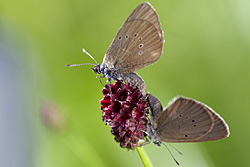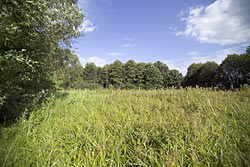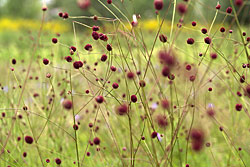Press release December 19th, 2005
Hay or butterflies?
UFZ researchers design a programme that reconciles nature conservation with agricultural use of meadows
Leipzig. Scientists at the Centre for Environmental Research Leipzig-Halle (UFZ) have developed a software programme that calculates the best time for cutting hay and the necessary compensation payments for farmers to enable better protection of rare butterfly species. The software was developed as part of the EU-funded MacMan project (www.macman-project.de), which studies habitats of endangered animal and plant species. The scientists’ intention is to show that nature conservation and agricultural use of meadows are not mutually incompatible, but rather that protection of biodiversity in our cultural landscapes is dependent on close cooperation with agriculture.

Mating of Maculinea nausithous
Source: André Künzelmann, UFZ

Marsh area near Leipzig, Germany / Habitat for Large Blue butterlies
Source: André Künzelmann, UFZ

The great burnet Sanguisorba officinalis. Maculinea nausithous and teleius need the great burnet to lay their
eggs on the leaves.
Source: André Künzelmann, UFZ
It appears to be a dilemma with no way out: if farmers mow their meadows in May and August, as they have done up till now, the Large Blue butterflies
(Maculinea nausithous and teleius) stand no chance of survival. This is because these butterflies lay their eggs on the great burnet (Sanguisorba
officinalis) in July. The caterpillars that emerge from the eggs have specialised on this plant. If this plant is not present, the Large Blues have no
chance to lay their eggs. However, if the hay is not cut at all, the meadow becomes overgrown and the black-backed meadow ants (Myrmica) cannot survive. Yet
the Large Blues need them too because it is the ants that ensure that the caterpillars survive and turn into butterflies the following summer – butterflies that
lay eggs and reproduce. The caterpillars of the Large Blues use a chemical trick to get the ants to carry them into their nests, occasionally feed them like a
cuckoo and bring them through the winter.
The solution: meadows in which rare butterflies are found should ideally be mown late – in September – and then only every two years. However, other mowing
systems could also allow the Large Blues to survive, although to a lesser extent. But lower yields and poorer quality hay mean losses for the farmer. The
scientists at the UFZ will therefore use their software to calculate case by case how many compensation payments would be necessary to win over farmers to
butterfly-friendly farming. The implementation of the European Habitats’ Directive forces countries to establish management plans over the next few years for
the protection of endangered species.
This dual dependence on the right plant and the right species of animal makes the Large Blues so interesting to science. Since it reacts very sensitively to
environmental influences, scientists can use it as an alarm signal. Where Large Blues disappear, nature changes too and other species are threatened. This
means that the butterflies – like all butterflies in principle – act as bioindicators.
Indicator species like these are a part of the MacMan research project, which has been studying the protection of habitats for endangered animal and plant
species over the past four years. This research project received EU funding of 3 million Euros and was led by the UFZ. Basing their research on butterflies
that occur in large areas of Europe and yet face a serious threat of extinction, the team investigated the factors that lead to the decline of species and
the possible countermeasures. At the beginning of December, over 150 scientists from 20 countries met in Leipzig to discuss the results of the research
project.
Tilo Arnhold
Further information are available over:
PD Dr. Josef Settele
UFZ, Department of Community Ecology
phone ++49 345 558 5320
E-mail: josef.settele@ufz.de
www.ufz.de/index.php?en=817
or over
Helmholtz-Zentrum für Umweltforschung - UFZ
UFZ, Public Relations
Doris Böhme, Tilo Arnhold
phone ++49 341 235-2278
E-mail: presse@ufz.de
